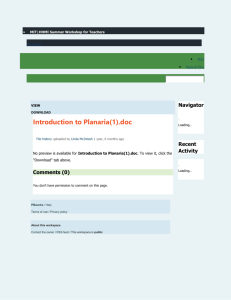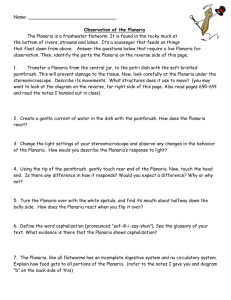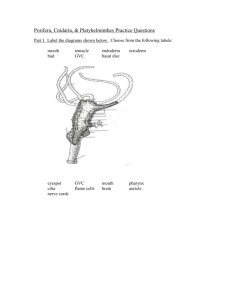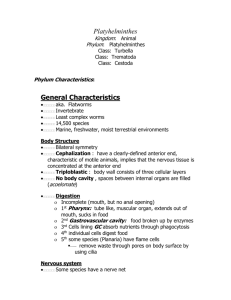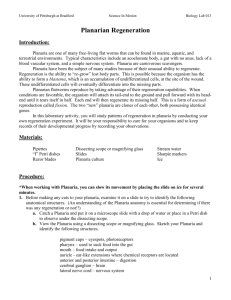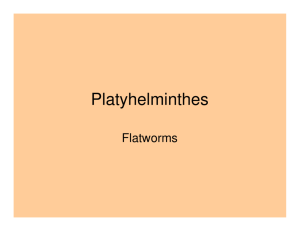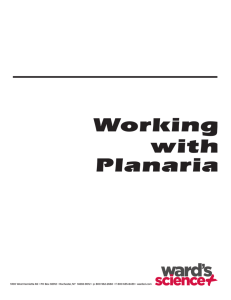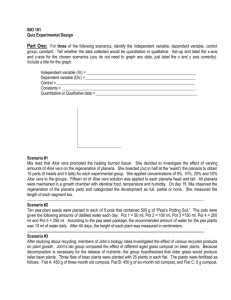critter
advertisement
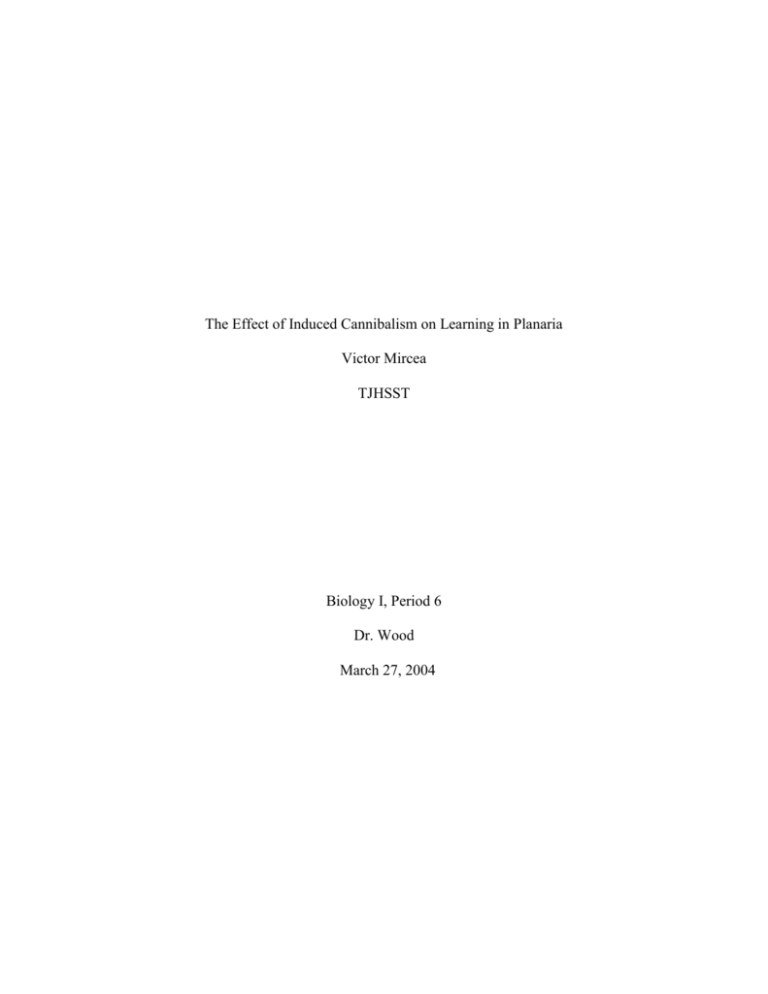
The Effect of Induced Cannibalism on Learning in Planaria Victor Mircea TJHSST Biology I, Period 6 Dr. Wood March 27, 2004 2 Contents Introduction ……………………………………………………………….. 3 Literature Review …………………………………………………. 3 Planaria ……………………………………………………. 3 Generational cannibalism …………………………………. 5 Learning …………………………………………………… 7 Experimental Design ……………………………………………… 8 Materials and Methods ...……………………………………………………8 Technology Component ……………………………………………. 8 Apparatus …………………………………………………... 8 Operation …………………………………………………… 9 Procedures and Materials …………………………………………... 9 Results ……………………………………………………………………… 10 Data …………………………………………………………………. 10 Statistics …………………………………………………………….. 11 Graphs ………………………………………………………………. 11 Discussion …………………………………………………………………... 11 Analysis …………………………………………………………….. 11 Summary ……………………………………………………………. 12 Bibliography ………………………………………………………………… 14 Appendix ……………………………………………………………………. 15 3 Introduction The purpose of this experiment was to find the effect of generational cannibalism on the transfer of learning in planaria. Transfer of intelligence through RNAi is an important concept, because RNAi can modify key genes and DNA to change traits, such as memory and intelligence. The hypothesis of this experiment was that if the generation of the planaria increases, then the time to respond to stimuli would decrease. This response to stimuli is a form of simple intelligence. The null hypothesis of this experiment was that if the generation of the planaria increases, then the time to respond to stimuli would remain constant. Literature Review Planaria. Planarian is a common name for several genera of the free-living (turbellarian) flatworms belonging to the order Tricladida, a name that comes from their characteristic threebranched digestive cavities. Most species of planarians range from 1/8 inches to about 1 inches in length (.32–2.54 cm) although some giant tropical forms range up to 2 feet (60 cm) (McConnell, 1966). The different species are white, gray, brown, or black; a few forms are transparent. Many are striped or streaked and some are brightly colored. Although planarians exist in marine or moist terrestrial habitats, most inhabit freshwater areas. Planarians in the wild often eat small snails and other small herbivores. They crawl about over a trail of mucus that they secrete by specialized epidermal cells; the smaller forms move about by means of cilia on their ventral, or lower, surface, and larger species utilize muscular contractions as well. Tactile and chemoreceptive cells (react to certain chemicals located in the environment), located in the epidermis, serve as general sense organs. In many species, these cells clump in 4 lobes at the sides of the head (Brown, Dustman, & Beck, 1965). Most planarians are also light sensitive and in some, pigmented light-sensitive cells clump in two cups that serve as primitive eyes. Planarians are usually either carnivorous or scavengers, depending on the species. Certain types of planarians are cannibalistic, and thus they will attempt to ingest any other small creatures that are around them, including other planarians. The mouth is located near the middle of the ventral, or lower surface. Planarians are hermaphroditic; each individual worm contains both male and female organs, and, most commonly, they reproduce sexually (Best, 1960). However, species similar to the half-inch long (1.27-cm) Dugesia tigrina, which is the most common planarian in the United States, are studied in classrooms and laboratories for their additional capacity to reproduce asexually by transverse rupture of the body. A rupture line develops behind the mouth, and while the back half of the worm anchors, the front half moves forward until the worm snaps in half. Each half regenerates the missing parts. Such planarians can also regenerate parts that they lose from their bodies (Brown, Dustman, & Beck, 1965). There have been several studies done on the subject of planarian intelligence that increases because of the cannibalization of other planaria that have already mastered a skill. The trend from these studies makes it seem that intelligence transfers. The fact that planaria possess this skill has many great implications. If humans could imitate this process somehow, intelligence would transfer simply by ingesting learning pills (McConnell, 1966). Another odd thing about planarians is that, when cut in certain places, they will reproduce incorrectly, forming many interesting mutations. These can include, but are not limited to, having multiple heads, having almost an entire planarian budding off one another, and having multiple tails. Theoretically, it is possible to have a planarian with 20 tails and 20 heads, but it would probably pull some extra heads and tails off before it reaches that milestone. 5 Generational Cannibalism. The independent variable of this experiment is generation cannibalism. In the 1960s, one of the most talked about areas of neuroscience-concerned reports that chemical extracts, isolated from animals that had been subjected to classical conditioning paradigms, could enhance learning when transferred to their naïve counterparts (Smalheiser, Manev, & Costa, 2001). A prominent worker in this field, James V. McConnell (1966), established that planarians (flatworms) reliably turn in response to light or vibration. Taking advantage of the regenerative capacity of planarians, he separated the head (containing the brain) from the tail in trained animals, and reported that persistent behavioral changes occurred in animals that regenerated from either half. In their report, Brown, Dustman, and Beck (1965) talked about how planaria trained under conditions that resulted in little or no learning in other animals (temporally separated light and shock) and with different levels of conditioned stimulus luminance. Temporally separated light and shock resulted in increased responsiveness that resembled altered behavior of planaria trained with simultaneous light and shock. Increased luminance also caused increased responsiveness. The data indicated that shock sensitizes planaria to light and causes spontaneous division of the animals, resulting in shorter worms that are more responsive. The combined effects of these variables resulted in increased response levels that others attribute to learning. McConnell (1966) published an article in the journal Nature that reported results of classical conditioning in brown planaria (Dugesia tigrina). In his study, he paired an electrical shock (conditioning stimuli) with a flash of light (unconditioned stimuli). When the shock would occur, the worms would contract and turn at the anterior end. The experiment’s control was a group that received no electric shock, and a group that received light and shock at random. After 6 training, the planaria received stimulus by light alone without electric shock. The planaria exhibited the same type of response originally caused by the electric shock. McConnell followed these tests with extinction trials that is they "reverse trained" the planaria to forget their earlier learning. Best (1960) suggested that perhaps "memory" is everywhere, in every cell, as it were, dispersed throughout the whole organism. It is true that scientists believe memory is stored and transferred via RNA, but perhaps memory is contained in every living cell. RNAi occurs when double-stranded RNA that is expressed within, or taken up by, cells, is cleaved into smaller protein-bound fragments that hybridize to endogenous cellular sequences, resulting in selective degradation of specific endogenous mRNAs and the consequent suppression of individual gene functions. The RNAi describes dozens of different genes in a variety of invertebrate phyla, including planaria. Of the amazing features of RNAi that attract attention, it is relevant here to note that one can induce RNAi by simply injecting doublestranded RNA into the body cavity in vivo, or even by feeding animals with bacteria that express exogenous RNAs. According to Smalheiser, Manev, and Costa (2001), RNAi is something that occurs in planaria, and it can transfer memory, as well as knowledge in these organisms. Planaria may perform certain actions by using stimuli, under training. However, the details and complexities of these mechanisms are not explicit to any degree of precision. All the evidence seems to point to the fact that every cell holds memory (McConnell, 1966). This is an important topic because, as Smalheiser, Manev, and Costa (2001), said, if one can master RNAi, they could create a way to transfer knowledge, and memory, from one person to another, with enough research. The evidence shows how, RNAi can be directly linked to memory; because it can modify the cell, to have certain properties, which means that memory can be created. 7 Learning. The fruit fly, Drosophila melanogaster, demonstrates its associative learning abilities in both classical and operant conditioning paradigms. Efforts to identify the neural pathways and cellular mechanisms of learning generally focus largely on olfactory classical conditioning. Results derived from various genetic and molecular manipulations provide considerable evidence that this form of associative learning depends critically on neural activity and cAMP signaling in brain neuropil structures called mushroom bodies (Siwicki & Ladewski, 2003). Operant conditioning, under experimental studies, reveals a controversial relationship between associative learning and possible motor learning. Motor learning and its underlying neural substrates, although extensively studied in mammals, is still not explicit in invertebrates. The visual discriminative avoidance paradigm of Drosophila at the flight simulator has been widely used to study the flies' visual associative learning and related functions, but it does not explain the motor learning process (Wang, Li, Feng, & Guo, 2003). In addition, the visual and olfactory cues used during navigation by livestock species do not offer a clear explanation. Evidence suggests that pigs do not acquire and maintain the use of visual cues while foraging. Other studies suggest that swine can learn multiple-choice spatial tasks, but that the first problem encountered influences their ability to learn subsequent tasks (Croney, Adams, Washington, & Stricklin, 2003). In non-associative learning, an animal learns about the properties of a stimulus presented alone. It either decreases (habituation) or increases (sensitization) its responses to that stimulus after repeated exposure (Siwicki & Ladewski, 2003). Many believe hierarchical organization is a distinctive feature in brain information processing, and the underlying mechanism of the formation of multi-layered neural circuits is an essential problem in brain science. The established theoretical method of training multi-layered 8 neural networks is the well-known back propagation algorithm. Although this method is very powerful, and has succeeded in many application studies, several problems make it biologically implausible. Error signals in the post-synaptic neuron propagate backwards to the pre-synaptic neuron against the spike flow. Watanbe, Masuda and, Aihara (2003) introduce a biologically plausible method of implementing reinforcement learning to multi-layer neural networks. The key idea is to localize spatially the synaptic modulation induced by reinforcement signals, proceeding downstream from the initial layer to the final layer (Watanabe, Masuda, & Aihara, 2003). See Figure 1 in the appendix. Experimental Design The independent variable in the experiment was generational cannibalism, which means the generation of the tested planaria. The levels of the independent variable were first through fifth generation planaria, each feeding the next generation. The control group was the first generation. For every level of the independent variable, there were ten trials. The dependent variable was learning, as measured by the response to stimuli, which was measured in units of time. The amount of food given to the planaria, the amount of water they were kept in, and the number of planaria they were kept in contact with remained constant. Materials and Methods Technology Component Apparatus. The apparatus in this experiment was a pulsing light. A pulsing light blinks on and off at a specified frequency (a given number of on and off switches per second, measured in hertz.) The light in this circuit is designed to be very intense, and to blink on and off repeatedly. The shorter bursts of light energy stimulate the test subject differently than a continuous beam. This 9 design also makes it easier to measure exactly the amount of time in between bursts, because the apparatus can be precisely designed, as opposed to switching a light on and off. This makes the experiment much more precise, as the exact amount of light applied (time of exposure) is easily determined. This circuit operates by means of a feedback loop of three logical “not” gates. This loop feeds a MOSFET (an electronic component which allows current to flow in certain situations), which either turns on or off current powering a light. The times when the MOSFET are on can be determined by changing the values of the capacitor and two resistors in the feedback loop. The apparatus allows for total control, limited only by available resistors and capacitors. See Figure 2 in the appendix. Operation. To operate the circuit, the desired frequency for light pulsing must be decided. In addition, the required resistors and capacitor must be obtained as determined by the formula F = .556 / RC. These required resistors and capacitor must then be placed into the circuit, thus replacing current ones. Then, the circuit must be placed with the light facing the desired test subject, and the wires for the battery must be placed in the labeled buses to activate the circuit. See Figure 3 in the appendix. Procedures and Materials The materials needed for this experiment were 50 brown planaria (dugesia tigrina), 6 Petri dishes, and 10 bottles of spring water, latex gloves, 1 assembled circuit, and 1 small stone. Prior research determined the levels. Any change seemed to cap off approximately five generations. Planaria fed to the next generation was approximately constant; this determined the number of planaria tested on for the prior level. In addition, wearing gloves throughout the entire experiment insured safety. 10 Ten planaria were taken out of their container and placed into a Petri dish, and labeled generation one. This was repeated four more times for every generation, increasing the generation number by one each time. One planaria from the Petri dish marked “generation one” was placed onto a separate Petri dish and was then stimulated by the circuit. The time that it took to evade the bright light emitted by the circuit was then recorded. This was repeated nine times for a total of ten repeated trials. Ten planaria were then put into a bowl and ground up with a rock. The generation marked “two” fed on the resulting mixture. This was repeated for four additional levels of the independent variable, replacing the generation number in the above paragraph with one more each time, and omitting crushing the generation five planaria, as there was no generation “six”. Results Data The Effect of Generational Cannibalism on the Learning Rate of Planaria Generation (Generation #) Time to respond to stimuli (seconds) Average 1 2 3 4 5 6 7 8 9 10 time to (tri responds als to stimuli ) (seconds) I 24 29 23 24 31 22 19 28 46 24 27 II 16 23 19 16 26 28 27 23 23 18 21.9 III 18 16 14 16 21 24 21 26 14 22 19.2 IV 15 22 22 16 15 14 18 18 16 17 17.3 V 16 19 14 14 15 16 17 14 15 12 15.2 As the generation number went up, the time to respond to stimulus went down significantly. The planaria seemed to make more mistakes at lower generations. They would go in one direction and turn around, but near the higher generations, they would go in one direction, at a fast pace, without doubling back. Statistics 11 See the statistics table in the appendix (Table 1). The effects of generational cannibalism on the learning rate of planaria are summarized in the table above. As the generation number became greater, the planaria took less and less time to respond fully to the stimuli. The change was noticeable from the first generation to the second, but after that, it began to decrease slowly with each generation. The final generation’s mean was nearly half of the first’s (27 compared to 15.2). The variance of the results also went down with each generation as well. At first, there was a large variance (7.56), which then went gradually decreased, ending up at 1.93 in “generation five”. The Statistical Package for the Social Sciences (Windows version 11.0.1) was used to perform the ANOVA test in order to test the following null hypothesis at the .05 level of significance: The learning rate of planaria is not significantly affected by generational cannibalism. The null hypothesis was rejected (p = 0.0011 < α = .05 at df = 3). The data did support the research hypothesis that generational cannibalism in planaria will cause a significant change in learning. Graphs See Figure 4 in the appendix. Discussion Analysis As the number of generations increased, the time it took the planaria to responds to stimuli decreased. The independent variable was generational cannibalism, planaria often ingest each other in the wild, and when they ingest other planaria, they acquire RNAi, which can facilitate the transfer of learning. The topic and dependent variable was transfer of learning in planaria. Planaria have been used in many experiments to see how they respond to stimuli, because they can be easily conditioned. They easily learn from stimuli and have a rudimentary 12 memory system. This learning is transferred through RNAi, which is provided by generational cannibalism. RNAi occurs when double-stranded RNA that is expressed within cells is cleaved into smaller protein-bound fragments that hybridize to endogenous cellular sequences, resulting in selective degradation of specific endogenous mRNAs and the consequent suppression of individual gene functions (Smalheiser, Manev, & Costa, 2001). What RNAi essentially does, is to turn off and on certain genes, such as in this case, when the gene for the knowledge that the planaria in the prior generation held was turned on. What this means is that planaria can learn by ingesting other planaria who have learned something in the past. In “generation one”, the value 46 was a significant outlier (z = 2.51, critical value of z = 2.29, p < .05) and thus was removed from calculations. This point may have occurred because a planarian was damaged, or because it had a different reaction to the stimulus than the other planaria. The findings of this experiment were similar to those identified by prior research (McConnell, 1966). The experiment proved that planaria respond to and learn from stimuli, and that this knowledge can then be transferred through RNAi to other planaria. There are several implications related to humans for this experiment. If RNAi could be harnessed, humans would be able to turn off genes that are considered bad, and turn on genes that are considered good. This could lead to curing many diseases. The knowledge gained from experimenting with natural instances of RNAi is a helpful step in the right direction, towards being able to use and apply the findings. Summary The purpose of the experiment was to determine whether intelligence would be transferred through cannibalism in planaria. The major finding of the experiment was that planaria do gain intelligence from ingesting other planaria. The hypothesis was supported by that 13 data, and the null hypothesis was rejected. This experiment correlates well with what was found out in prior experiments, that planaria learn through cannibalism by means of RNAi. The possible explanation for these findings is that planaria do learn from other planaria, and that they do this through RNAi switching on and off certain genes in their cells. There are several possible experiments that could be done with the planaria besides the one performed, to measure transfer of intelligence. One possible future experiment would be to observe behavior over ten generations instead of five, in order to see whether and when the learning hits a limit. In addition, one could attempt to use different stimuli to see if the same results are accomplished. 14 References Best, J. S. (1960, August). Diurnal cycles and cannibalism in planaria. Science, 131, 1884-1885. Brown, H., Dustman, R., & Beck, E. (1965, December). Sensitization in planaria. Physiology & Behavior, 1(3-4), 305-308. Brown, H., Dustman, R., & Beck, E. (1965, December). Experimental procedures that modify light response frequency of regenerated planaria. Physiology & Behavior, 1(3-4), 245-249. Croney, C., Adams, K., Washington, C., & Stricklin, W. (2003, October). A note on visual, olfactory and spatial cue use in foraging behavior of pigs: indirectly assessing cognitive abilities. Applied Animal Behavior Science, 83(4), 303-308. McConnell, J. (1966). Comparative physiology: Learning in invertebrates. Annual Review of Physiology, 28, 107–136. Sanjuan, M., Alonso, G., & Nelson, J. (2003, November). Blocked and test-stimulus exposure effects in perceptual learning re-examined. Behavioural Processes, Article in press, corrected proof. Smalheiser, N., Manev, H., & Costa, E. (2001, April). RNAi and brain function: Was McConnell on the right track? Trends in Neurosciences, 24(4), 216-218. Siwicki, K., & Ladewski, L. (2003, September). Associative learning and memory in Drosophila: Beyond olfactory conditioning. Behavioural Processes, 64(2), 225-238. Wang, S., Li Y., Feng, C., & Guo, A. (2003, August). Dissociation of visual associative and motor learning in Drosophila at the flight simulator. Behavioural Processes, 64(1), 57-70. Watanabe, M., Masuda, T., & Aihara, K. (2003, September). Forward propagating reinforcement learning: Biologically plausible learning method for multi-layer networks. Biosystems, 71(1-2), 213-220. 15 Appendix Figure 1 16 Figure 2 Figure 3 17 Figure 4 The Effect of Generational Cannibalism on Learning in Planaria Time to respond to stimuli (seconds) 30 25 20 15 10 5 0 1 2 3 4 5 Generation (Generation Num ber) As the generation of planaria increases, the time to respond to stimulus decreases. Table 1 The Effect of Generational Cannibalism on the Learning Rate of Planaria Descriptive Information Mean (Amount of time to adjust to stimulus in seconds) Standard Deviation Repeated Trials 1 27 2 21.9 Generation Number 3 19.2 7.56 4.43 4.21 2.79 1.93 10 10 10 10 10 Results of ANOVA test df = 3, F = 5.51, p = 0.0011 < α = .05 4 17.3 5 15.2
